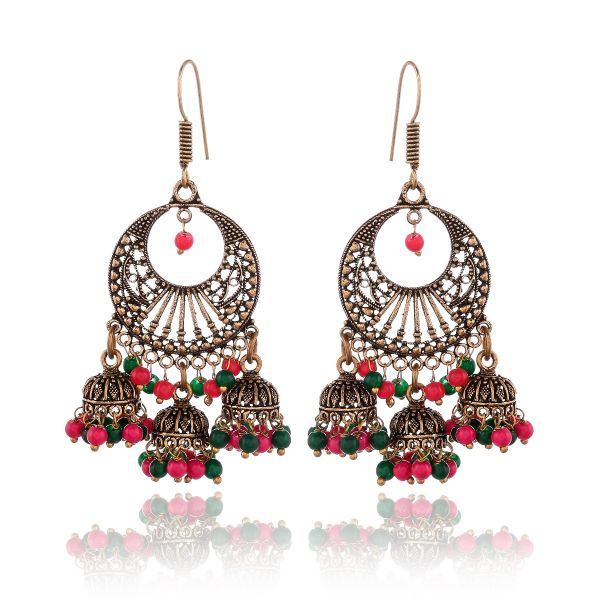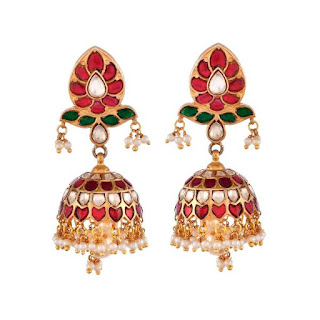Why Hoop Earrings Have Become The New Style Statement
No accessory tops off an outfit like a pair of stunning hoop earrings; they are bold, eye-catching and are considered as a powerful style statement. The trend of wearing hoops has caught quite a rage right now, it is everywhere; be it the celebrities, influencers or us the ‘common people’. However, one might be surprised by the deep cultural aspect these gorgeous circles hold.
The tradition of wearing hoops is centuries old, thousands of men and women from various cultures have proudly worn these earrings as a sign of resistance and cultural identity. Hoops are some of the oldest accessories that have been around for generations and stood the test of time. They can be found in numerous ancient cultures and still remain a significant style trend worldwide.
But have you ever wondered about the origin of these earrings? The symbolism and the culture behind these earrings?
It's time to do some digging into the incredible history of hoops. From ancient beginnings to the contemporary trends that encircle this single accessory.
The Ancient Origins
The very first thing to note is that these earrings have been around for centuries. They also became popular across many cultures in the ancient world. It is believed that the hoop earrings first made their debut in areas around Mesopotamia. Historians also believe that Sumerian women wore the first gold hoop earrings around 2500 BCE. Simultaneously, the people belonging to the African civilization, Nubia (now Sudan), were also some of the first to wear hoops in the world.
Over time, hoop earrings were ingrained into other cultures and traditions. They also were worn in Egyptian culture around 1500 BCE. Well all of this makes us question why was this particular accessory so universally beloved throughout different cultures? According to some historians in different parts of the world, the hoop earrings symbolized wealth and various cultural aspects, while others also wore them to emphasize their beauty.
Supported by rich symbolism, hoop earrings eventually made their way into other parts of the world. Greek goldsmiths started to make hoop earrings in the first millennium, BCE. Etruscan goldsmiths weren’t far behind. The Greeks and Etruscans created their own variation, which they considered a sign of wealth and prosperity. Both cultures took pride in combining accessory with art while conceptualizing their rendition of this beloved jewelry. Each set featured intricate designs and embellishments like beads, gemstones and flowers.
Hoop earrings eventually made their way into other parts of the world by being supported from its rich symbolism. In Greece, the goldsmiths started to create their own hoop earrings during the first millennium. The Etruscan goldsmiths weren’t far behind from them. The Greeks and Etruscan created their very own versions of hoop earrings, which they considered to be a sign of wealth and prosperity. Both the cultures took pride in combining their art while the rendition of their jewellery. Each pair were featured with intricate detailings and were encrusted with beads and gemstones.
Hoop earrings were thoroughly welcomed in the Roman Empire, it was widely worn by the men and women. Even the famous emperor Julius Caesar wore hoop earrings. Later on as Roman’s influence over the world declined the Byzantine empire adopted this accessory. Their hoops were made of gold with pearl embellishments hanging from chains.
Hoop Earrings and the stigma
Fast forward in the early 20th century, the United States, a wave of negativity spread around this accessory. As wearing hoops were a huge part of the Latino or the Native American culture, many saw them as ‘uncultured’ and ‘loud’. Many stopped wearing these earrings so that they won’t get recognized as immigrants. It was deeply racist and was also considered cultural appropriation because of the upheld stigma and shame around these earrings.
Although it was short lived, this accessory bounced right back into the fashion domain.
Hoops and women empowerment
In the 1960s, more and more women belonging to the Latin and African American community wore hoop earrings as a symbol of female power and stood against the stigma and culture appropriation of this accessory. Hoop earrings became synonymous with female empowerment and upliftment during the decades of 60s and 70s. They were also considered an accessory for making a power statement. Minorities and immigrants in Europe and United States wore the hoops as a symbol of strength, identity and resistance towards discrimination.
Hoops in the present day
Women belonging to the Latin and African American communities began to wear hoops again in the year 1980s. Hoops are still a central accessory in these communities. For many hoops are more than an accessory, these earrings are deeply embedded into their pride and empowerment as women of colour. Hoops are a symbol of their culture, ancestry and strength. Women and men have worn hoops throughout the ancient times and they remain to be an important part of their cultural identity, tradition and as a sign of resisting the colonization.
The newer trends
Apart from all the other factors, hoop earrings have continued to become one of the most popular accessories worldwide. There are many variants that are available in the market. Despite being originated in gold, hoop earrings are now duly made with industrial metals like brass and copper. They are also available in precious metals like silver, often featured with other precious and semi-precious gemstones.
Hoops made of silver and other industrial materials have become more popular due their affordability. Due to the rising inflation, unlike gold jewellery, silver does not burn a hole in the pockets and offer premium styles at the same time. One can find a plethora of designs that are gracing the market everyday be it the small and simple ones, the gold plated, the studded ones etc.
Check our website for more designer hoop earrings.


Comments
Post a Comment